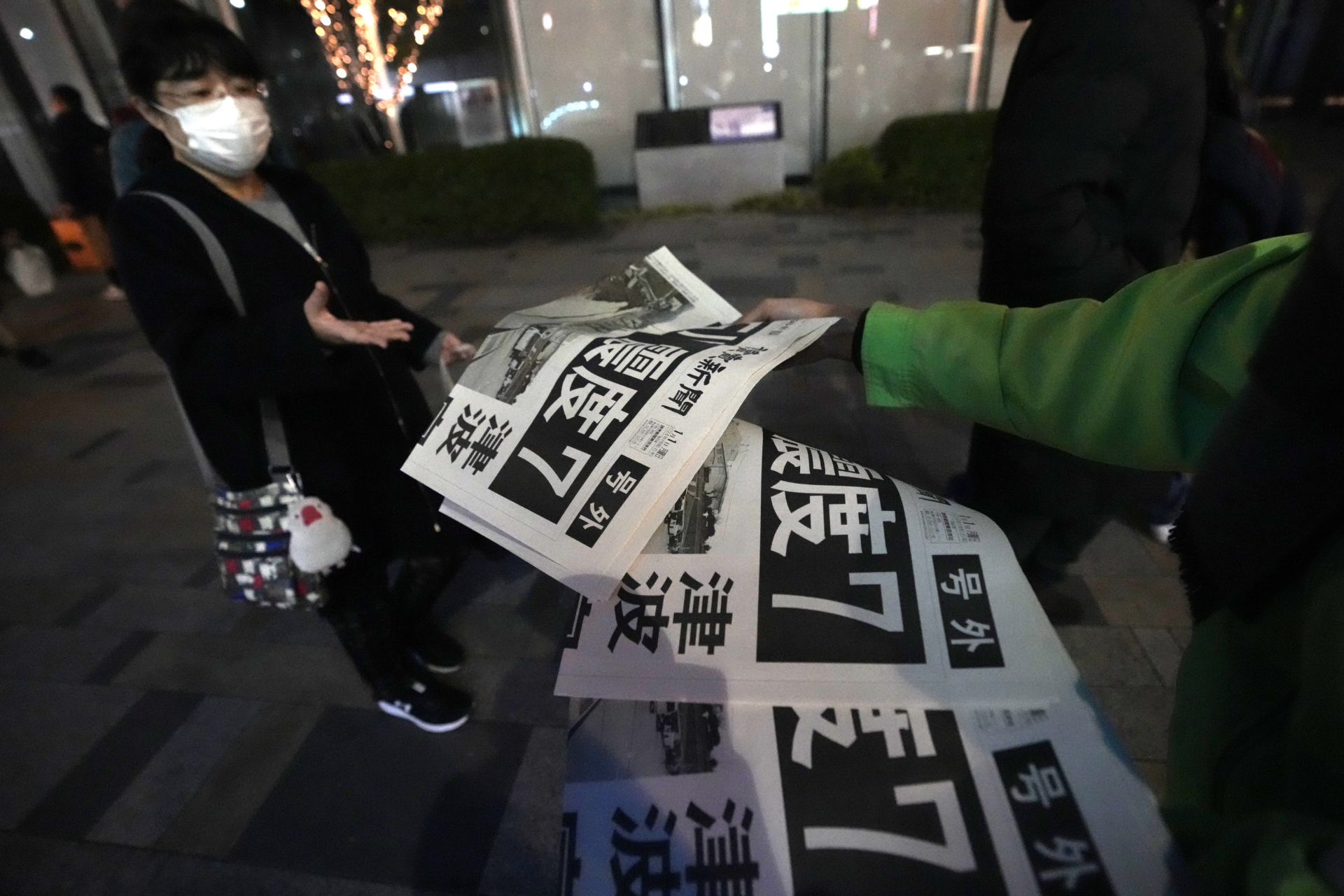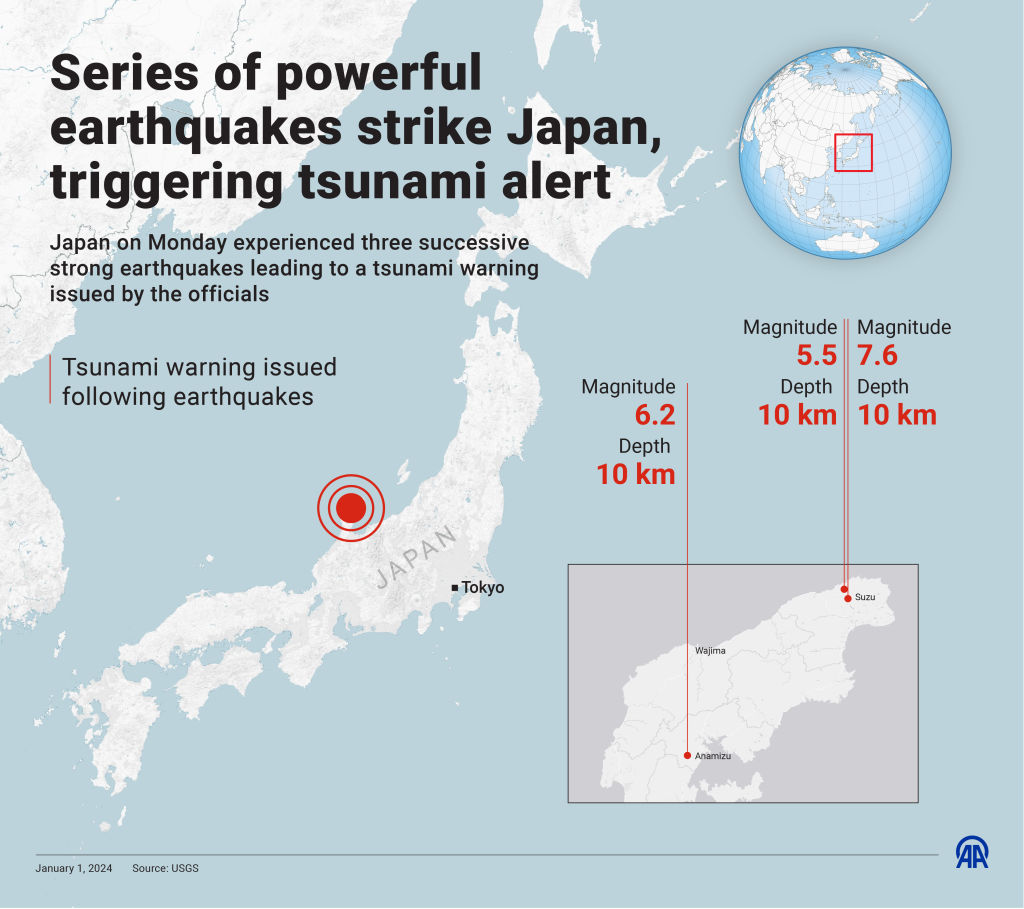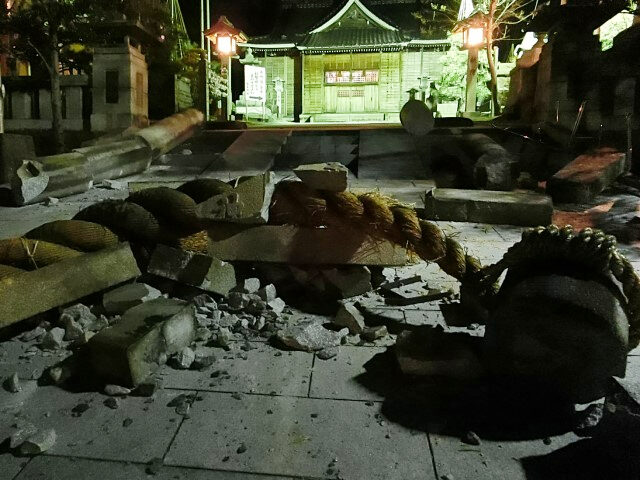People living on the coast in north-central Japan have been ordered to evacuate to high ground after a large earthquake struck the Noto Peninsula on Monday afternoon, with the government warning of a potential five-meter (16-foot) tsunami.
A 7.6 magnitude earthquake struck the Noto Peninsula in Ishikawa Prefecture, the central region of Japan’s main island Honshu, around 1600JST (0200EST, 0700 GMT), the most powerful earthquake in that area since records began. Japanese state broadcaster NHK is telling citizens: “The tsunami has already arrived. Please run away as soon as possible… Please remember the Great East Japan Earthquake. Please run away as soon as possible to save your life”.
Update 0645EST: ‘Major Tsunami Warning’ downgraded for Noto
Some good news, perhaps, the urgent “major tsunami warning” issued for the Noto Peninsula, under which the 7.6 magnitude earthquake struck during Japan’s Monday afternoon has been downgraded to a “tsunami warning”, with the expected wave height falling from five meters to three meters. The evacuation order is still very much in place, however, and those in the ‘red’ area covering most of central-northern Japan’s coast have been told:
Tsunami damage will occur.
People in coastal areas or along rivers should immediately evacuate to a safe location such as higher ground or an evacuation building.
Tsunamis strike repeatedly. Do not leave your safe area until the warning has been lifted.
Ishikawa has requested the Japanese Self-Defence Ground Force (Army) to deploy to assist with disaster relief.
やばかった地震 pic.twitter.com/MqDmH2uSIk
— ♧=こはね=♧@メメントモリW34🍄 (@2BB98NfJwDre0Di) January 1, 2024

People receive extra edition of Yomiuri Shimbun newspaper reporting the earthquakes Monday, Jan. 1, 2024 in Tokyo. Japan issued tsunami alerts and ordered evacuations following a series of earthquakes on Monday that started a fire and trapped people under rubble on the west coast of its main island. The headline reads ” Earthquake intensity 7.” (AP Photo/Shuji Kajiyama)
Japan’s nuclear power stations in the impacted area say they are operational and cooling pools are being operated with no abnormal readings, despite damage to power supply systems in some areas. NHK reports Masayuki Seki of the National Emergency Response Center, said of the nuclear plants: “We are doing our best to gather information as the earthquake continues.
“At the moment, we are making efforts to ensure power for safety-critical equipment and for cooling spent fuel. Since the earthquakes have already taken place, I don’t think there is any particular need to take evacuation actions. I would like to ask residents to first ensure their own safety in the event of an earthquake.”
志賀原発”安全上重要な機器の電源は確保”緊急時対応センターhttps://t.co/BDFAzo9u3E #nhk_news
— NHKニュース (@nhk_news) January 1, 2024
Update 0630EST: Wounded arriving as hospitals deal with power outage
While the earthquake epicentre struck beneath a rural peninsula and away from Japan’s greatest population centres, there are a number of cities nearby in the Ishikawa Prefecture. A doctor at the hospital in Suzu city, Ishikawa spoke to Japanese television and said while more injured were coming in but the earthquake had damaged infrastructure and was making treatment more difficult. He is reported to have said: “Patients injured in the earthquake have been brought in… The condition of the roads has deteriorated due to the earthquake.
“Some doctors are unable to reach the hospital because the condition is getting worse, and we don’t have enough staff. Also, the electricity at the hospital has been cut off, so we are using backup power.”
In Noto hospital, which is under a major tsunami warning, patients have been evacuated to the 5th floor of the building.
Read more:
A tsunami with a height of 1.2 meters (four feet) has already landed, but given the power of the earthquake, the Japanese government predicted a tsunami of five meters is yet to come to the Ishikawa Prefecture. The Japanese government is advising those on the north coast of Honshu to seek high ground, or else a tall building.
Toshihiro Shimoyama, the Japanese government’s Earthquake Information Planning Officer, said in a televised press conference about the earthquake that: “A major tsunami warning has been issued… I want people to evacuate to a safe place. Tsunamis will repeatedly strike, so I hope people will stay in a safe place until the tsunami warning is lifted.
“In areas where the shaking was strong, there is an increased risk of house collapses and landslides, so please be careful of future seismic activity and rain conditions, and stay in the area for about a week, especially for the next few days.”
The highest purple alert has been issued for the Noto peninsula, where residents have been told to expect the five-meter tsunami: “A large tsunami will strike, causing severe damage. People in coastal areas or along rivers should immediately evacuate to a safe location such as higher ground or an evacuation building. Tsunamis strike repeatedly. Do not leave your safe area until the warning has been lifted.”
A lesser but still serious red warning is in place along the north-central Japan coast warning of a three-meter tsunami. People in that area have been given similar advice. A yellow warning has been issued for the eastern and western-most coasts of Japan’s north-facing prefectures, where a one-meter wave is expected and the public are told it is dangerous to “be in the sea or near the coast” and that those in the water should get out and move away from the shore.
While the tsunami poses a major risk to life and property in the coming hours, serious damage has already been caused by the large earthquake that has triggered it, and Japan continues to be struck by dozens of powerful aftershocks. Government minister Yoshimasa Hayashi said in a press conference that houses had collapsed, 33,000 houses had no power, and in six cases people had been “buried alive” by falling buildings. Roads, rail, and airports are closed.

ANKARA, TURKIYE – JANUARY 01: An infographic titled ‘Series of powerful earthquakes strikes Japan, triggering tsunami alert’ created in Ankara, Turkiye on January 1, 2024. (Photo by Muhammed Ali Yigit/Anadolu via Getty Images)
This story is developing, more follows.

COMMENTS
Please let us know if you're having issues with commenting.